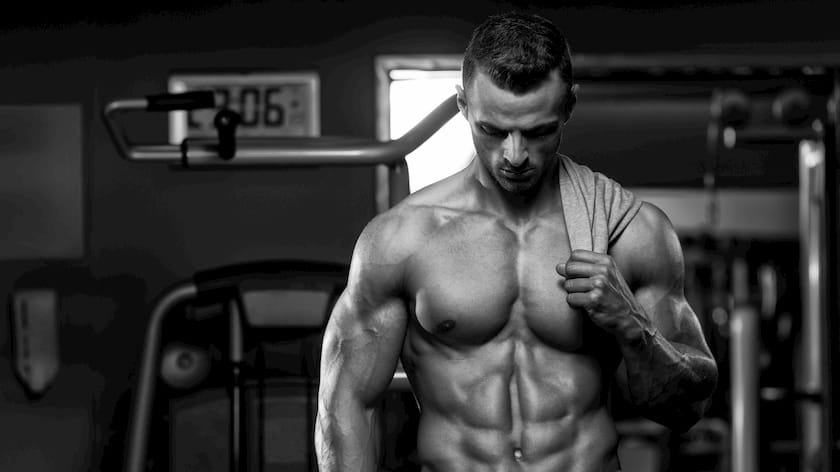Throughout my 15 years of weightlifting, I’ve found one workout routine to dominate—the 5-day split. If your goal is to build the most muscle in the least time (in other words, you are a bodybuilder) and get ripped, the 5-day workout routine is optimal.
It has the perfect number of days to hit the gym and, when done correctly, will yield gains you have only dreamed of.
The 5-day split follows a form of training that Arnold Schwarzenegger, arguably the most successful bodybuilder in history, utilized and perfected during the 70s. This form of training, know as split training, has become the default weight training system for building muscle.
However, it can be a bit tricky to set up. Before getting into this, let’s look at some of the ideas behind split training.
What is Split Training?
There are two main systems of weight training—split training and full-body training. The primary differences between the two are the load exerted on the muscles and the time spent in the gym.

Split training targets specific muscle groups on specific days. The major muscle groups are chest, shoulders, legs, upper and lower back, arms, and abdomen.
How these muscles should be grouped together is highly debated although I believe there is an optimal way, which will be discussed later.
There are many valid ways to set up a split routine. For example, you may choose to target the muscles of the upper body every Monday and the muscles of the lower body every Friday. This would be referred to as a 2-day upper/lower split.
Another common split is the three day PPL split, which calls for training “push,” “pull,” and leg related movements on three separate days. The four-day split typically involves a back, chest, shoulder, and leg day.
What is Full-Body Training?
Full-body training is the opposite of split training. Instead of training muscle groups on specific days, the entire body is trained once, twice, or even three times each week.
Why is full-body training limited to a few sessions per week? Wouldn’t training ALL muscle groups every day be most effective? It certainly would … assuming you can recover fast enough. However, unless you are using performance-enhancing drugs, this is impossible to do. For the average athlete, the American College of Sports Medicine (ASCM) suggests at least 48 hours of rest between high-intensity exercising of the same muscle groups.
If you train full-body on Monday, the earliest you could train again would be Wednesday, but if you decide to train only chest on Monday, you could train legs the following day and shoulders the day after that. Therein lies the beauty of split training.
That’s not to say full-body training is bad. On the contrary, it’s one the best modes of training for beginners as it allows enough time for recovery and focuses on compound movements. Full-body training is preferable for those who have limited time, are new to resistance training, or have goals of improving general health. For packing on serious muscle quickly, however, split training is king.
What is a 5-Day Split and Why is it Useful?

The 5-day split, as suggested by its name, is a split routine that calls for 5 workout sessions per week. It’s a great routine for building muscle because it targets each muscle group really well.
The pectoral muscle, for instance, develops fastest when trained for an hour every 5–6 days. The biceps and triceps, which are much smaller, require less time to recover and should be trained twice a week (Charlebois, 2007). All of this is simply not possible with a 2- or 3-day split.
Constructing a proper split is complicated, and I see so many people doing it incorrectly. When you train 5 days a week, you need to make sure you are being efficient. Working out for an hour a day, 5 times a week, is a huge time investment.
In this article, I demonstrate the best 5-day workout routine. A perfect 5=day split considers more than just what body part is trained each day. It considers what workouts are done, the number of sets and repetitions, and even the length of the workout.
I also show you the mistakes that many bodybuilders make. In learning the art of building a workout split, you will gain a lot of effective bodybuilding knowledge. Implement the knowledge you obtain from this guide, and I guarantee you will see major improvements!
Who is the 5-Day Workout Split For?
For anyone who has the time for it! Whether you’re a professional bodybuilder or a novice lifter, male or female, you should implement a 5-day split to build muscle quickly.

Going to the gym 5 days a week can be a hassle, but if you are determined, you will make time. Sometimes, doing so is simply impossible due to work or school restrictions, which is why we develop an additional split that includes an at-home core workout. Four out of the five workouts will be at the gym, and one will be in the comfort of your home.
What Is the Best 5-Day Workout Routine to Get Ripped?
Here is a overview of the 5-day workout routine discussed here. For specific workouts, please refer to the section below titled “The Completed Version!”
- Chest + (Light) Triceps
- Back + (Light) Biceps
- Rest (Core Workout—optional)
- Shoulders + (Heavy) Triceps
- Legs + (Heavy) Biceps
- Rest (Light Core Workout)
How to Construct the Best 5-Day Workout Split
Let’s consider and critique a 5-day split that a user recommended on a bodybuilding forum.
- Day 1: Shoulders
- Day 2: Chest
- Day 3: Arms
- Day 4: Legs
- Day 5: Back
Take a moment, and try to spot some errors.
The biggest issue is that the chest and shoulder muscles are trained too closely together.
Why is this a problem?
Well, no chest workout targets the pectoral muscles exclusively. For example, the bench press, in addition to targeting the pectoral muscles, targets the anterior deltoids (the front head of the shoulders), the triceps brachii, and the latissimus dorsi (back).
Of the three additional groups that a chest press targets, the most heavily targeted is the anterior deltoid (in addition to the triceps, but we will get to that later). The same goes for most chest exercises. It is therefore logical to separate chest and shoulder days as far as possible, correct?
Let’s do that.
- Day 1: Shoulders
- Day 2: Legs
- Day 3: Arms
- Day 4: Chest
- Day 5: Back
I prefer to separate chest and shoulders by two days as they are very interconnected muscle groups. You might be thinking, “If chest day is moved to day 4, isn’t it now separated from the next shoulder workout by a day?”
The solution to this issue leads to another problem with the original split—It has no rest days! For a 5-day split, I find it best to rest a day during the split and rest a day after completing the 5 workouts. Here’s what I mean:
- Day 1: Shoulders
- Day 2: Legs
- Rest Day
- Day 3: Arms
- Day 4: Chest
- Day 5: Back
Rest between day 2 and day 3, then rest after completing all workouts.
- Day 1: Shoulders
- Day 2: Legs
- Day 3: Rest
- Day 4: Arms
- Day 5: Chest
- Day 6: Back
- Day 7: Rest
In this version, you lift five days a week and rest two days. You may find that resting a single day will suffice. In that case, ignore day 7 and return to day one after completing day 6.
We have now separated chest and shoulder workouts appropriately, but they are not separated equally (shoulders, 3 days; chest, 2 days; shoulders, 3 days, etc.). Chest day comes 3 days after shoulder day, and shoulder day comes 2 days after chest day. Does it matter which group is allowed more time to rest?
Absolutely. Consider any chest press and any shoulder press. A chest press activates the anterior deltoid muscle to a certain degree. A shoulder press (such as the military press) only hits the shoulder muscles when done with proper form. Let’s call the military press a 90° press. The flat bench is therefore a 0° press and the incline press is a 45° press.

As you increase the angle, you activate more of the deltoid muscles and less of the pectoral muscles. Therefore, a flat bench press activates less deltoid muscle than an incline bench press, which activates less deltoid muscle than a military press. You can go below zero degrees to isolate the chest even more (i.e., a decline bench press). The concept also applies to flyes. This is important to keep in mind as you are constructing your own split. If you separate chest and shoulder days by one or two days, you should focus on flat and decline presses and flyes during chest day.
Another thing to consider while pressing is your hand placement. The farther apart your hands are, the more you target the chest. The closer your hands are, the more you target the triceps. So if you are hitting triceps the day after chest day, do not do any close grip presses.
Lets jump back to the split.
- Day 1: Shoulders
- Day 2: Legs
- Day 3: Rest
- Day 4: Arms
- Day 5: Chest
- Day 6: Back
- Day 7: Rest
Because chest exercises activate the shoulders muscles more than shoulder exercises activate chest muscles, we should swap chest and shoulder day:
- Day 1: Chest
- Day 2: Legs
- Day 3: Rest
- Day 4: Arms
- Day 5: Shoulders
- Day 6: Back
- Day 7: Rest
On the first day, we hit chest, and on day two, we hit legs. Your legs should not be sore from a chest workout … so far so good. We rest on the third day, then hit arms on the fourth day.
Is it a good idea to devote an entire day to muscles as small as the biceps and triceps? I say no for two reasons. Firstly, these muscles are small, so they require less time to recover. It is therefore optimal to train them twice a week (Charlebois, 2007). Secondly, having a single arm day can interfere with other workout days. Consider the fact that all shoulder presses activate the triceps. Thus, hitting shoulders the day after arms is not optimal. You may be able to do shoulder raises the next day, but you won’t be able to shoulder press a lot of weight with sore triceps.
On which days should we work out biceps and triceps? All pushing movements require triceps activation and all pulling movements require bicep activation. So, let’s pair the triceps with chest and shoulders and the back with the biceps. We agreed that the biceps should be worked out twice a week, so let’s pair them with leg day.
- Day 1: Chest + Triceps
- Day 2: Legs + Biceps
- Day 3: Rest
- Day 4: Shoulders + Triceps
- Day 5: Back + Biceps
- Day 6: Rest
Doing two full-blown bicep and triceps workouts a week might work well for you. I find the sweet spot to be somewhere between hitting them once a week and hitting them twice a week. In other words, implementing a “heavy” and “light” day. Here is what I mean:
- Day 1: Chest + (Light) Triceps
- Day 2: Legs + (Heavy) Biceps
- Day 3: Rest
- Day 4: Shoulders + (Heavy) Triceps
- Day 5: Back + (Light) Biceps
- Day 6: Rest
On “light” days, do 1–2 workouts (6–8 sets) and on heavy days, do 3–4 workouts (9–12 sets). Chest workouts target the triceps more than shoulder workouts do, so it’s better to pair the “light” day with the chest and the “heavy” day with the shoulders. By hitting biceps heavy on leg day, we allow two days for the biceps to recovery before we work out the back. The worst thing for a back workout is sore biceps as almost every single back movement requires heavy bicep activation.
The next issue we encounter is the proximity of shoulder day to back day. Have you ever done lateral or front shoulder raises and found your back and trap muscles to be extremely sore the next day? I know I have. Those movements are extremely difficult to do without activating the back muscles.
How do we target the posterior deltoid muscle on shoulder day without burning out our back? On which day do we hit traps? If you hit traps on shoulder day, your back will be very sore the following day. It’s best to separate these two muscle groups as far as possible, as we did with chest and shoulder.
- Day 1: Chest + (Light) Triceps
- Day 2: Back + (Light) Biceps
- Day 3: Rest
- Day 4: Shoulders + (Heavy) Triceps
- Day 5: Legs + (Heavy) Biceps
- Day 6: Rest
First, we train chest and triceps (lightly). On day two, it’s back and biceps (lightly). We rest on the third day and allow our triceps and pectoral muscles to fully recover for the following day’s shoulder workout. Then, we hit the legs and biceps heavy, both of which should be fully recovered at this point. We then rest and start the cycle over again the next day.
Perfect, isn’t it?
Not quite yet. We are forgetting two things: core workouts and cardio! Don’t underestimate the importance of a strong core. Whenever I’m asked for advice about building strength, I always advise core development.
For the sake of being active every day of the week, let’s do a core workout twice a week. On day three, we do a full-blown core workout, and on day 6, a light one (7–12 mins). On day 3, we also work on forearms and calves, both of which are relatively small muscle groups which should be targeted twice a week.
As regards cardio, I will leave that up to you. Some people prefer to do cardio every day before a workout. I will write an article on this soon.
Here is the completed split:
- Day 1: Chest + (Light) Triceps
- Day 2: Back + (Light) Biceps
- Day 3: Core + Forearms + Calves + Cardio
- Day 4: Shoulders + (Heavy) Triceps
- Day 5: Legs + (Heavy) Biceps
- Day 6: Rest (Light Core Workout at home optional)
How to Construct the Best 5-Day Workout Split (PART 2)
In the previous section, we developed the foundation for our 5-day workout split. If you skipped that section, please read it now as it contains valuable information. Now, we want to consider specific workouts, rep ranges, and number of sets.
Note that “light” and “heavy” do not refer to intensity or load, but rather the rep ranges and number of sets.
Day 1 (Chest + Light Triceps).

Do 3 chest presses, 2 chest flyes, and 1 or 2 workouts for triceps. Chest fly movements don’t require much tricep activation, so you can jump back and forth between flyes and triceps workouts. It is best to get the heavy presses out of the way first.
- Flat Bench Press: 4 Sets (8–10 reps)
- Incline Dumbbell Press: 4 Sets (8–10 reps)
- Triceps Pushdown – V-Bar Attachment: 3 Sets (9–12 reps)
- Decline Dumbbell Flyes: 3 sets(8–12 reps)
- Skull Crushers: 3 Sets (9–12 reps)
- Decline Bench Press: 3 Sets (8–10 reps each)
Day 2: Back + light Biceps

As someone who suffers from tennis elbow, I have to start my back days a little differently from most. As already mentioned, almost all pulling movements require heavy bicep activation. Therefore, I find it best to postpone biceps workouts towards the end of the workout.
Unlike with other muscle groups, this is a wide variation of back workouts. I find it best to reduce the sets to 2 and hit the back from multiple angles. This is a technique that was utilized by the great Dorian Yates.
- Seated Cable Rows: 2 sets (8–10 reps)
- Front Lat Pulldown: 2 sets (8–10 reps)
- Bent Over Barbell Rows: 2 sets (8–10 reps)
- Hammer Curls: 3 sets ( 8–12 reps)
- Deadlift: 2 sets (8–10 reps)
- Barbell Curl (EZ-bar): 3 sets (8–10 reps)
- Straight-Arm Pulldown: 2 sets (8–10 reps)
- Concentration Curls: 3 sets (8–12 reps)
Day 3: Core + Calfs + Forearms + Cardio
- Crunches : 3 sets of 10–12 reps
- Hanging Leg Raise: 3 sets of 10–12 reps
- Seated Russian Twist: 12–15 reps on each side
- Bicycle Crunches: 15–20 sets of max reps
- Planks: 3 sets max hold
- Palms-Up Barbell Wrist Curl: max reps for 3 sets. Start with the bar, and add 2.5 or 5 lbs after each set.
- Seated Calf Raise: 3 sets 8–15 reps
- Palm Down Barbell Wrist Curls Over Bench: max reps for 3 sets. Start with the bar, and add 2.5 or 5 lbs after each set.
- Smith Machine Calf Raise: 3 sets 8–15 reps
- 25 mins of cardio before or after the workout
Day 4: Shoulders + Heavy triceps

My personal favorite workout day! First, do the heavy presses, then alternate shoulder raises and flyes with triceps workouts.
- Seated Dumbbell Press: 4 sets (8–10 reps)
- Military Press: 4 sets (8–10 reps)
- Dips: 4 sets (8–10 reps)
- Side Lateral Raise: 4 sets (8–12 reps)
- Standing Dumbbell Triceps Extension: 4 sets (8–12 reps)
- Front Lateral Raise: 4 sets (8–12 reps)
- Triceps Pushdown — Rope Attachment: 4 sets (8–12 reps)
- Reverse Flyes: 4 sets (8–12 reps)
- Shrugs: 3 sets (8–10 reps)
Day 5: Legs + Heavy Biceps

I have always struggled with leg workouts. I was never able to squat deeply enough, and my legs always wobbled under a lot of stress. A few years ago, I did some research and discovered the problem.
It turned out I was wearing the wrong shoes. Running and basketball shoes are terrible for weightlifting. One of the best investments I’ve made was purchasing a proper pair of weightlifting shoes. All my lifts went up, and I no longer felt pain in my knees and lower back.
- Squats: 4 sets (6–8 reps)
- Wide-Grip Standing Barbell Curl: 4 sets (8–12 reps)
- Leg Press: 3 sets (8–10 reps)
- Spider Curl: 4 sets (8–10 reps)
- Smith Machine Calf Raise: 4 sets (8–12 reps)
- Lying Leg Curls: 3 sets (8–12 reps)
- Machine Bicep Curl: 3 sets (8–12 reps)
- Leg Extensions: 3 sets (8–12 reps) NOTE: please skip if you have knee complications.
Day 6: Rest + light core workout
Day 6 is a rest day, but you can do a light 7-12 core workout in the morning if you are up for it. Return to day 1 the following day.
The Completed Version!
You can swap exercises (or drop a few if you want), although I highly recommend you follow the routine as closely as possible. It’s challenging, but it will yield great results. What’s important is the order of the days. For instance, if you plan to target your chest today, you don’t have to target your back tomorrow (you can rest instead), but your next workout should be a back workout.
Day 1: Chest + Light Triceps
- Flat Bench Press: 4 Sets (8–10 reps)
- Incline Dumbbell Press: 4 Sets (8–10 reps)
- Triceps Pushdown – V-Bar Attachment: 3 Sets (9–12 reps)
- Decline Dumbbell Flyes: 4 sets(8–12 reps)
- Skull Crushers: 3 Sets (9–12 reps)
- Decline Bench Press: 4 Sets (8–10 reps each)
Day 2: Back + (Light) Biceps
- Seated Cable Rows: 2 sets (8–10 reps)
- Front Lat Pulldown: 2 sets (8–10 reps)
- Bent over Barbell Rows: 2 sets (8–10 reps)
- Hammer Curls: 3 sets ( 8–12 reps)
- Deadlift: 2 sets (8–10 reps)
- Barbell Curl (EZ-bar): 3 sets 8–10 (reps)
- Straight-Arm Pulldown: 2 sets (8–10 reps)
- Concentration Curls: 3 sets (8–12 reps)
Day 3: Core + Calfs + Forearms + Cardio
- Crunches : 3 sets of 10–12 reps
- Hanging Leg Raise: 3 sets of 10–12 reps
- Seated Russian Twist: 12–15 reps on each side
- Bicycle Crunches: 15–20 sets of max reps
- Planks: 3 sets max hold.
- Palms-Up Barbell Wrist Curl: max reps for 3 sets. Start with the bar, and add 2.5 or 5 lbs after each set.
- Seated Calf Raise: 3 sets 8–15 reps
- Palm Down Barbell Wrist Curls Over Bench: max reps for 3 sets. Start with the bar, and add 2.5 or 5 lbs after each set.
- Smith Machine Calf Raise: 3 sets 8–15 reps
- 25 mins of cardio before or after the workout.
Day 4: Shoulders + (Heavy) Triceps
- Seated Dumbbell Press: 4 sets (8–10 reps)
- Military Press: 4 sets (8–10 reps)
- Dips: 4 sets (8–10 reps)
- Side Lateral Raise: 4 sets (8–12 reps
- Standing Dumbbell Triceps Extension: 4 sets (8–12 reps)
- Front Lateral Raise: 4 sets (8–12 reps)
- Triceps Pushdown – Rope Attachment: 4 sets (8–12 reps)
- Reverse Flyes: 4 sets (8–12 reps)
- Shrugs: 3 sets (8–10 reps)
Day 5: Legs + (Heavy) Biceps
- Squats: 4 sets (6-8 reps)
- Wide-Grip Standing Barbell Curl: 4 sets (8–-12 reps)
- Leg Press: 3 sets (8–10 reps)
- Spider Curl: 4 sets (8–10 reps)
- Smith Machine Calf Raise: 4 sets (8–12 reps)
- Lying Leg Curls: 3 sets (8–12 reps)
- Machine Bicep Curl: 3 sets (8–12 reps)
- Leg Extensions: 3 sets (8–12 reps) NOTE: please skip if you have knee complications.
Day 6: Rest (Light Core Workout)
- Rest day (optimal light core workout in the morning)
Day 7: Rest


